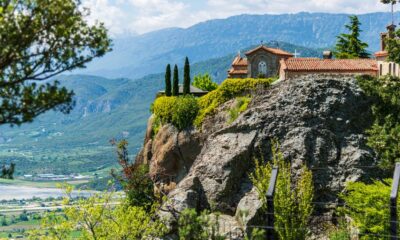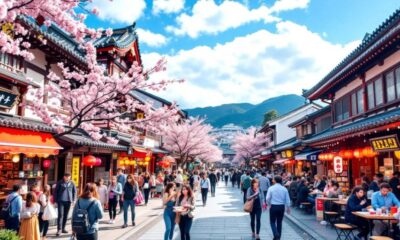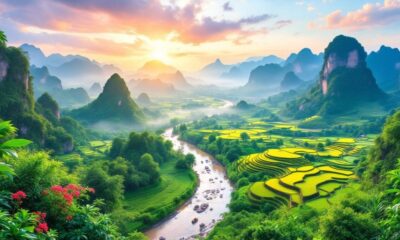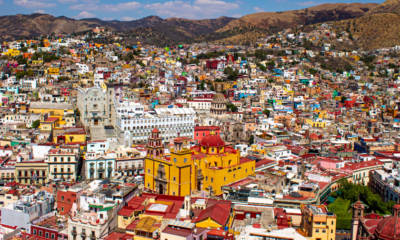Destinations
A 77-Photo Round-the-World Trip: From the Alps to the Amazon

This article takes you on a fascinating journey around the globe, showcasing stunning photographs that capture the beauty and diversity of our planet. From the majestic Alps to the lush Amazon, each location offers a unique story and perspective. Join us as we explore 77 breathtaking images that highlight the wonders of nature and culture across various continents.
Key Takeaways
- The Alps are known for their stunning landscapes and rich culture.
- The Amazon River Basin is home to diverse wildlife and ancient traditions.
- Antarctica offers a unique experience with its icy terrain and wildlife.
- Easter Island is famous for its mysterious Moai statues and rich history.
- Sicily boasts beautiful scenery and ancient ruins, making it a must-visit.
1. Alps
The Alps are a stunning mountain range that stretches across several countries in Europe, including France, Switzerland, Italy, and Austria. Known for their breathtaking views and outdoor activities, the Alps attract millions of visitors each year. Here are some highlights of what makes the Alps special:
- Diverse Activities: From skiing and snowboarding in winter to hiking and mountain biking in summer, the Alps offer a variety of activities for all ages.
- Rich Culture: The region is home to charming villages, delicious cuisine, and unique traditions that reflect the diverse cultures of the countries involved.
- Stunning Landscapes: The majestic peaks, lush valleys, and crystal-clear lakes create a picturesque setting that is perfect for photography.
Key Facts about the Alps
| Feature | Details |
|---|---|
| Highest Peak | Mont Blanc (4,808 m) |
| Length | Approximately 1,200 km |
| Countries Involved | France, Switzerland, Italy, Austria |
The Alps are not just a destination; they are a wonderful experience that combines nature, adventure, and culture.
As part of our series on making our best trail running images in the Alps, we explore the story behind capturing the best trail running photos in this magnificent region. The beauty of the Alps is truly unmatched, making it a perfect backdrop for any adventure.
2. Amazon River Basin
The Amazon River Basin is a vast and vibrant ecosystem, home to countless species and unique cultures. This region is often referred to as the lungs of the Earth due to its immense biodiversity and crucial role in regulating the global climate.
Key Features of the Amazon River Basin
- Diverse Wildlife: The basin is home to over 2.5 million insect species, thousands of plants, and numerous animals, including jaguars, pink dolphins, and sloths.
- Indigenous Cultures: Many indigenous tribes still live in harmony with nature, relying on the river for transportation and sustenance.
- Environmental Importance: The Amazon plays a vital role in carbon storage, helping to combat climate change.
Fun Facts
- The Amazon River is the second longest river in the world, stretching over 4,000 miles.
- It is estimated that 20% of the world’s fresh water flows through the Amazon.
- The basin covers approximately 5.5 million square kilometres, spanning across several countries including Brazil, Peru, and Colombia.
The Amazon River Basin is not just a geographical feature; it is a living library of biodiversity and culture, reminding us of the importance of preserving our natural world.
Challenges Facing the Amazon
- Deforestation: Large areas are being cleared for agriculture and logging, threatening wildlife and indigenous communities.
- Pollution: Mining and industrial activities are contaminating the river and its surroundings.
- Climate Change: Altered weather patterns are affecting the delicate balance of this ecosystem.
In conclusion, the Amazon River Basin is a treasure trove of life and culture, but it faces significant threats that require urgent attention and action.
3. Antarctica
Antarctica is a land of extremes, where the icy wilderness meets breathtaking beauty. This vast continent is home to stunning landscapes, including towering icebergs and expansive glaciers. Here are some key points about this unique destination:
Key Features of Antarctica
- Extreme Cold: Temperatures can drop below -60°C in winter.
- Unique Wildlife: Home to penguins, seals, and various seabirds.
- Stunning Landscapes: Icebergs and glaciers create a breathtaking scenery.
Travel Challenges
Travelling to Antarctica is not for the faint-hearted. Here are some challenges you might face:
- Harsh Weather: Prepare for unpredictable weather conditions.
- Limited Access: Only accessible via specific tours or cruises.
- Physical Demands: Activities like hiking and kayaking require good fitness.
Antarctica offers a rare glimpse into a world where nature reigns supreme, making it a must-visit for adventurous travellers.
Fun Facts
| Fact | Description |
|---|---|
| Largest Desert | Antarctica is the largest desert in the world. |
| No Permanent Residents | Only temporary research stations exist. |
| Unique Ecosystem | Home to species found nowhere else on Earth. |
In conclusion, visiting Antarctica is a once-in-a-lifetime experience that combines adventure with the chance to witness breathtaking wildlife in their natural habitat. Prepare well, and you will create memories that last forever!
4. Easter Island
Easter Island, known as Rapa Nui, is one of the most isolated places on the planet. This magical island is famous for its mysterious Moai statues, which have intrigued visitors for generations. Here are some key points about this unique destination:
Key Features of Easter Island
- Moai Statues: These giant stone figures are scattered across the island and represent the ancestors of the Rapa Nui people.
- Cultural Significance: The island has a rich history and is a UNESCO World Heritage Site, showcasing the unique culture of its inhabitants.
- Natural Beauty: With stunning landscapes, including volcanic craters and beautiful beaches, Easter Island offers breathtaking views.
Visitor Information
| Aspect | Details |
|---|---|
| Best Time to Visit | April to June and September to November |
| Main Activities | Hiking, exploring archaeological sites, and cultural tours |
| Local Cuisine | Try traditional dishes like "Po’e" and fresh seafood |
Easter Island is not just a destination; it’s a journey into a world of ancient mysteries and breathtaking beauty.
Whether you are an adventurer or a history buff, this island promises an unforgettable experience. Don’t miss the chance to explore its rich culture and stunning landscapes!
5. Galapagos Islands
The Galapagos Islands are a unique paradise located in the Pacific Ocean. They are famous for their incredible wildlife and stunning landscapes. Here, you can see animals that exist nowhere else on Earth, making it a vital spot for biodiversity.
Wildlife Wonders
- The islands are home to the famous Giant Tortoises, which can live for over 100 years.
- You can also find the Blue-footed Booby, known for its bright blue feet.
- The Marine Iguana is the only lizard that swims in the ocean.
Conservation Efforts
The Galapagos Islands are a UNESCO World Heritage site, and many efforts are in place to protect their unique environment. Here are some key points:
- Strict regulations on tourism to minimise human impact.
- Ongoing research to understand and protect local species.
- Community involvement in conservation projects.
The Galapagos Islands remind us of the importance of protecting our planet’s wildlife. They play a crucial role in maintaining ecological balance and biodiversity, which is essential for the health of our world.
Fun Facts
| Fact | Description |
|---|---|
| Darwin’s Inspiration | Charles Darwin developed his theory of evolution after visiting these islands. |
| Unique Species | Many species found here are endemic, meaning they are not found anywhere else. |
| Volcanic Origins | The islands were formed by volcanic activity, creating stunning landscapes. |
6. Mongolia
A Land of Vast Landscapes
Mongolia is a country of stunning beauty and rich history. The vast steppes and rugged mountains offer breathtaking views that are unlike anywhere else in the world. Here, you can experience the traditional nomadic lifestyle that has persisted for centuries.
Unique Culture and Traditions
Mongolia is home to a vibrant culture shaped by its history and geography. The people, known for their hospitality, often live in ger tents and rely on livestock for their livelihood. Here are some key aspects of Mongolian culture:
- Nomadic Lifestyle: Many families move with the seasons, following their herds.
- Traditional Festivals: Events like Naadam celebrate wrestling, horse racing, and archery.
- Cuisine: Dishes often include mutton, dairy products, and unique breads.
Exploring the Gobi Desert
The Gobi Desert is one of the most famous regions in Mongolia. It is known for its extreme temperatures and unique wildlife. Here are some highlights:
- Flora and Fauna: Home to rare species like the Bactrian camel and snow leopards.
- Historical Sites: Discover ancient dinosaur fossils and the ruins of the Silk Road.
- Adventure Activities: Opportunities for hiking, camel riding, and camping under the stars.
Mongolia is a land where the past meets the present, offering a unique glimpse into a world that has remained largely unchanged for centuries.
Travel Tips
If you’re planning a trip to Mongolia, consider these tips:
- Pack for the Weather: Temperatures can vary greatly, so bring layers.
- Learn Basic Mongolian Phrases: This can enhance your interactions with locals.
- Respect Local Customs: Understanding traditions will enrich your experience.
Mongolia is a captivating destination that promises adventure and discovery. Whether you’re exploring the Gobi Desert or experiencing the warmth of its people, this country will leave a lasting impression.
7. Morocco
Morocco is a land of vibrant colours and rich traditions. The local markets are a feast for the senses, filled with spices, textiles, and crafts that reflect the country’s diverse culture. Visitors can explore bustling souks, where bargaining is part of the experience, and discover hidden gems in every corner.
Highlights of Moroccan Culture
- Cuisine: Moroccan food is famous for its unique flavours, with dishes like tagine and couscous being must-tries.
- Architecture: The intricate designs of mosques and palaces showcase the country’s artistic heritage.
- Festivals: Events like the Marrakech International Film Festival celebrate local and international talent.
Must-Visit Places
- Marrakech: Known for its historic medina and vibrant souks.
- Chefchaouen: Famous for its blue-painted streets and stunning mountain views.
- Sahara Desert: Experience the breathtaking sunsets and starry nights in the vast dunes.
Morocco offers a unique blend of ancient traditions and modern influences, making it a captivating destination for travellers.
For those over 30 and seeking small-group travel, Morocco is a perfect choice. Discover the hidden gems and cultural wonders, and start planning your Moroccan adventure with over30experiences today!
8. Sicily
Sicily, the largest island in the Mediterranean, is a treasure trove of history and beauty. With its stunning landscapes and rich culture, it captivates every visitor. From ancient ruins to vibrant markets, Sicily offers a unique blend of experiences.
Highlights of Sicily
- Valley of the Temples: A UNESCO World Heritage site featuring well-preserved ancient Greek temples.
- Mount Etna: One of the most active volcanoes in the world, offering breathtaking views and hiking opportunities.
- Palermo: The capital city, known for its lively street markets and diverse architecture.
Key Attractions
| Attraction | Description | Location |
|---|---|---|
| Valley of the Temples | Ancient Greek ruins set in a beautiful landscape | Agrigento |
| Mount Etna | Active volcano with hiking trails | Catania |
| Palermo Cathedral | Stunning architecture and historical significance | Palermo |
Sicily is not just a destination; it’s an experience that stays with you long after you leave.
Whether you’re exploring the ancient ruins or enjoying the local cuisine, Sicily is a place that promises unforgettable memories. Don’t miss out on the 22 best places to visit in Sicily to make the most of your trip!
9. Southeast Asia

Southeast Asia is a vibrant region filled with breathtaking landscapes and rich cultures. From the bustling streets of Bangkok to the serene rice paddies of Vietnam, this area offers a unique blend of tradition and modernity. Visitors can experience the lively Buddhist culture, which is deeply rooted in the daily lives of the locals.
Key Highlights:
- Diverse Cultures: Each country has its own unique traditions and customs.
- Delicious Cuisine: Street food is a must-try, with flavours that will tantalise your taste buds.
- Stunning Nature: From lush jungles to beautiful beaches, the scenery is simply stunning.
Travel Tips:
- Respect Local Customs: Always be mindful of local traditions, especially in religious sites.
- Stay Hydrated: The tropical climate can be hot and humid, so drink plenty of water.
- Bargain Wisely: Haggling is common in markets, but always do so respectfully.
Southeast Asia is a place where every corner tells a story. The blend of history, culture, and natural beauty makes it a must-visit destination for any traveller.
In conclusion, Southeast Asia is not just a travel destination; it’s an adventure waiting to unfold. With its 64 breathtaking travel photos, you can truly explore this diverse region and get inspired to visit through my perspective.
10. African Safari
The Thrill of the Wild
An African safari is a journey into the heart of nature, where you can witness incredible wildlife in their natural habitat. From the majestic elephants to the swift cheetahs, the experience is nothing short of breathtaking.
Best Locations for Safaris
- Kruger National Park (South Africa)
- Chobe National Park (Botswana)
- Hwange National Park (Zimbabwe)
Tips for a Successful Safari
- Choose the right season: The dry season (May to October) is best for spotting animals.
- Pack wisely: Bring binoculars, a camera, and light clothing.
- Stay quiet: Noise can scare away wildlife, so keep your voice down.
A safari is not just about seeing animals; it’s about connecting with nature and understanding the delicate balance of life in the wild.
Stunning Photography Opportunities
The landscapes and wildlife provide stunning African safari photography moments. Ever see a black rhino peeing? Or a giraffe sitting? This experience will inspire you to capture the beauty of Africa.
Conclusion
An African safari is a once-in-a-lifetime adventure that offers unforgettable memories and a deeper appreciation for wildlife conservation.
11. China
China is a vast country filled with incredible sights and rich history. From the ancient Great Wall to the bustling streets of modern cities, there is so much to explore. Here are some highlights:
Key Attractions
- Great Wall of China: A marvel of engineering stretching over 13,000 miles.
- Forbidden City: Once the home of emperors, this palace complex is a UNESCO World Heritage site.
- Tiananmen Square: One of the largest public squares in the world, steeped in history.
Unique Experiences
- Terra-Cotta Warriors: Discovered in Xi’an, these life-sized statues guard the tomb of China’s first emperor.
- Karst Landscapes in Guilin: Known for its stunning limestone hills and rivers, it’s a photographer’s paradise.
- Rainbow Mountains in Zhangye: Famous for their vibrant colours, these mountains are a natural wonder.
Cultural Insights
- Buddhist Temples: Explore ancient temples that showcase China’s spiritual heritage.
- Local Cuisine: Don’t miss trying Peking duck and dim sum, which are famous dishes.
- Traditional Festivals: Experience the vibrant celebrations during the Chinese New Year.
China is a land of contrasts, where ancient traditions meet modern advancements.
Summary Table of Key Sites
| Site | Location | Description |
|---|---|---|
| Great Wall of China | Northern China | Ancient fortification |
| Forbidden City | Beijing | Imperial palace |
| Terra-Cotta Warriors | Xi’an | Army of clay statues |
| Rainbow Mountains | Zhangye | Colourful geological formations |
| Karst Landscapes | Guilin | Scenic limestone hills and rivers |
12. Victoria Falls
Overview
Victoria Falls, one of the largest waterfalls in the world, is located on the border between Zambia and Zimbabwe. It is a breathtaking sight, with water cascading down a height of 108 metres. The local name, Mosi-oa-Tunya, means "The Smoke That Thunders," which perfectly describes the mist that rises from the falls.
Key Features
- Height: 108 metres
- Width: 1,708 metres
- Flow Rate: Up to 1,088 cubic metres per second during the rainy season
| Feature | Measurement |
|---|---|
| Height | 108 metres |
| Width | 1,708 metres |
| Flow Rate | Up to 1,088 m³/s |
Activities
Visitors to Victoria Falls can enjoy a variety of activities:
- Bungee Jumping: Experience the thrill of jumping from the Victoria Falls Bridge.
- White-water Rafting: Navigate the rapids of the Zambezi River below the falls.
- Helicopter Tours: Get a bird’s-eye view of the stunning landscape.
Victoria Falls is not just a natural wonder; it is a place where adventure meets beauty.
Conservation Efforts
Efforts are being made to protect this natural treasure:
- Community Involvement: Local communities are engaged in conservation projects.
- Sustainable Tourism: Initiatives are in place to promote eco-friendly tourism.
- Wildlife Protection: Measures are taken to safeguard the surrounding wildlife habitats.
Conclusion
Victoria Falls is a must-visit destination for anyone who loves nature and adventure. Its stunning beauty and thrilling activities make it a unique experience that should not be missed. Don’t forget to explore the local culture and perhaps shop for some leather clothes to take home as a souvenir!
13. Mont Blanc

The Majesty of Mont Blanc
Mont Blanc, the highest peak in the Alps, stands at an impressive 4,808 metres. This majestic mountain is not just a sight to behold; it is a popular destination for climbers and tourists alike. The breathtaking views and challenging trails attract adventurers from all over the world.
Key Facts about Mont Blanc
| Feature | Details |
|---|---|
| Height | 4,808 metres |
| Location | French-Italian border |
| First Ascent | 8 August 1786 |
| Best Time to Visit | June to September |
Activities to Enjoy
- Hiking: Numerous trails for all skill levels.
- Climbing: A challenge for experienced mountaineers.
- Photography: Capture stunning landscapes and wildlife.
Mont Blanc is a place where nature’s beauty meets adventure, making it a must-visit for any traveller.
Conservation Efforts
To protect this natural wonder, several initiatives are in place:
- Sustainable Tourism: Encouraging eco-friendly practises.
- Wildlife Protection: Safeguarding local flora and fauna.
- Waste Management: Ensuring the area remains clean and pristine.
Mont Blanc is not just a mountain; it is a symbol of adventure and natural beauty, drawing people to explore its heights and enjoy its wonders. Whether you’re hiking its trails or simply taking in the views, Mont Blanc offers an unforgettable experience.
14. Gobi Desert
The Gobi Desert is a vast and stunning landscape that stretches across northern China and southern Mongolia. It is known for its harsh climate and unique wildlife. Here are some key points about this remarkable desert:
Key Features of the Gobi Desert
- Size: The Gobi covers over 1.3 million square kilometres, making it one of the largest deserts in the world.
- Climate: It experiences extreme temperatures, ranging from scorching heat in summer to freezing cold in winter.
- Wildlife: Home to rare species like the Bactrian camel and the snow leopard, the Gobi is a vital habitat for these animals.
Cultural Significance
- The Gobi is not just a natural wonder; it is also rich in history. It was part of the ancient Silk Road, connecting East and West.
- Nomadic Tribes: Many Mongolian nomads still live in traditional yurts, maintaining a lifestyle that has changed little over centuries.
Visiting the Gobi Desert
- Best Time to Visit: The ideal months are from May to October when the weather is milder.
- Activities: Visitors can enjoy camel trekking, exploring ancient ruins, and experiencing local culture.
- Footwear: When exploring, it’s essential to wear suitable footwear to navigate the rugged terrain comfortably.
The Gobi Desert is a place where nature and culture intertwine, offering a glimpse into a world that has remained largely unchanged for centuries.
15. Forbidden City
The Forbidden City is a stunning palace complex located in the heart of Beijing, China. It served as the imperial palace for 24 emperors during the Ming and Qing dynasties. This vast area covers about 180 acres and is surrounded by a large defensive wall and a moat.
Key Features
- Architecture: The Forbidden City is known for its traditional Chinese palatial architecture, featuring intricate designs and vibrant colours.
- Cultural Significance: It is a symbol of Chinese heritage and has been designated a UNESCO World Heritage Site.
- Visitor Experience: Millions of tourists visit each year to explore its rich history and beautiful gardens.
Fun Facts
- The complex has 9999 rooms, which is a number believed to be auspicious in Chinese culture.
- The name "Forbidden City" comes from the fact that entry was strictly controlled, and commoners were not allowed inside.
- The layout of the city follows traditional Chinese cosmology, representing the relationship between heaven and earth.
The Forbidden City is not just a historical site; it is a living museum that showcases the grandeur of ancient Chinese architecture and culture.
Visitor Information
| Detail | Information |
|---|---|
| Opening Hours | 8:30 AM – 5:00 PM |
| Ticket Price | Approx. 60 CNY |
| Best Time to Visit | Spring and Autumn |
In conclusion, the Forbidden City is a must-visit for anyone interested in Chinese history and culture. Its beauty and significance make it a highlight of any trip to China.
16. Tiananmen Square

Tiananmen Square is one of the largest public squares in the world, located in the heart of Beijing, China. It is a place of great historical significance and has been the site of many important events in Chinese history.
Key Features of Tiananmen Square
- Monuments: The square is home to several important monuments, including the Monument to the People’s Heroes and the Mausoleum of Mao Zedong.
- Cultural Importance: It serves as a symbol of the Chinese nation and is often used for celebrations and ceremonies.
- Tourist Attraction: Millions of visitors come to explore its vastness and learn about its history each year.
Visiting Tips
- Plan Your Visit: Try to visit early in the morning to avoid crowds.
- Engage with Locals: Talking to local people can enhance your understanding of the square’s significance.
- Explore Nearby Attractions: Don’t miss the Forbidden City and the National Museum of China, which are just a short walk away.
Visiting Tiananmen Square offers a unique glimpse into China’s past and present. It’s a place where history and culture come alive, making it a must-see for anyone exploring Beijing.
Quick Facts
| Feature | Details |
|---|---|
| Area | 440,000 square metres |
| Year Established | 1949 |
| Notable Events | Protests in 1989 |
17. Terra-Cotta Warriors
The Terra-Cotta Warriors are a remarkable collection of sculptures that represent the armies of Qin Shi Huang, the first Emperor of China. Discovered in 1974 near Xi’an, these life-sized figures were buried with the emperor to protect him in the afterlife.
Key Features
- Historical Significance: The warriors date back to around 210–209 BC.
- Diversity: There are thousands of figures, including soldiers, horses, and chariots, each uniquely crafted.
- Artistry: The level of detail in the sculptures is astonishing, showcasing the skills of ancient Chinese artisans.
Visitor Information
| Aspect | Details |
|---|---|
| Location | Xi’an, Shaanxi Province |
| Year Discovered | 1974 |
| Number of Figures | Over 8,000 |
The Terra-Cotta Warriors are not just a tourist attraction; they are a glimpse into the past, revealing the grandeur of ancient China and the beliefs surrounding death and the afterlife.
Why Visit?
- Cultural Insight: Learn about the Qin Dynasty and its impact on Chinese history.
- Unique Experience: Witness one of the most significant archaeological finds in history.
- Educational Value: Gain knowledge about ancient Chinese art and military practises.
In summary, the Terra-Cotta Warriors offer a fascinating journey into the past, making them a must-see for anyone interested in history and culture.
18. Sahara Desert
The Sahara Desert is the largest hot desert in the world, covering an area of about 9.2 million square kilometres. It stretches across several countries in North Africa, including Algeria, Chad, Egypt, Libya, Mali, Mauritania, Morocco, Niger, Sudan, and Tunisia.
Key Features of the Sahara Desert
- Vast Sand Dunes: The Sahara is famous for its towering sand dunes, some reaching heights of over 250 metres.
- Unique Wildlife: Despite its harsh conditions, the desert is home to various animals, including camels, foxes, and lizards.
- Cultural Richness: The Sahara is inhabited by several nomadic tribes, each with its own traditions and lifestyles.
Climate and Weather
| Season | Average Temperature (°C) | Rainfall (mm) |
|---|---|---|
| Winter (Dec-Feb) | 10 – 20 | 0 – 10 |
| Summer (Jun-Aug) | 30 – 50 | 0 – 5 |
The Sahara is not just a barren land; it is a place of incredible beauty and rich history. Many ancient trade routes crossed this desert, connecting different cultures and peoples.
Travel Tips
- Stay Hydrated: Always carry enough water, as the desert can be extremely dry.
- Dress Appropriately: Wear light, breathable clothing to protect against the sun.
- Respect Local Cultures: Engage with local tribes and learn about their customs and traditions.
The Sahara Desert is a remarkable place that offers a unique blend of natural beauty and cultural heritage. Whether you’re exploring its vast landscapes or learning about its diverse communities, the Sahara is sure to leave a lasting impression.
19. Rocky Mountains
The Rocky Mountains are a stunning range that stretches over 3,000 miles across North America. They are known for their breathtaking views, diverse wildlife, and numerous outdoor activities. Here are some key highlights:
- Majestic Peaks: The Rockies boast some of the highest peaks in North America, including Mount Elbert, which stands at 14,440 feet.
- Wildlife: This region is home to a variety of animals, such as elk, bears, and mountain goats, making it a great spot for wildlife enthusiasts.
- Outdoor Activities: Visitors can enjoy hiking, skiing, and camping, making it a popular destination for adventure seekers.
| Feature | Description |
|---|---|
| Length | Over 3,000 miles |
| Highest Peak | Mount Elbert (14,440 feet) |
| Main Activities | Hiking, skiing, camping |
The Rocky Mountains offer a unique blend of natural beauty and adventure, making them a must-visit for anyone who loves the outdoors.
When visiting, don’t forget to pack your sunglasses to protect your eyes from the bright sun reflecting off the snow and peaks!
20. Moai Statues
The Moai statues of Easter Island are one of the most fascinating sights in the world. These giant stone figures, carved by the Rapa Nui people, stand as a testament to their rich culture and history.
The Significance of Moai Statues
- Cultural Heritage: The Moai represent the ancestors of the Rapa Nui people, serving as a connection to their past.
- Symbol of Power: The size and number of Moai on a site often indicated the power of the clan that built them.
- Mystery: The exact methods used to transport and erect these statues remain a mystery, sparking curiosity among historians and tourists alike.
Fun Facts About Moai Statues
| Fact | Description |
|---|---|
| Number of Moai | Over 900 statues exist on the island. |
| Height | The tallest Moai stands at 10 metres (33 feet). |
| Weight | Some Moai weigh over 80 tonnes! |
The Moai statues are not just stone figures; they are a symbol of resilience and creativity of the Rapa Nui people, showcasing their ability to create art from the land’s resources.
Visiting Easter Island to see the Moai is a unique experience that connects you to a culture that has thrived in isolation for centuries. Each statue tells a story, and together they form a remarkable landscape that continues to inspire awe.
21. Darwin’s Islands
A Unique Ecosystem
The Galapagos Islands are a treasure trove of biodiversity. They are famous for their unique wildlife, which played a crucial role in Charles Darwin’s theory of evolution. Here, you can find:
- Giant tortoises
- Marine iguanas
- Blue-footed boobies
The Importance of Conservation
These islands are not just beautiful; they are also fragile. Conservation efforts are vital to protect the unique species that call these islands home. Some key points include:
- Strict regulations on tourism
- Ongoing research and monitoring
- Community involvement in conservation
Visiting the Islands
When planning a trip to the Galapagos, consider the following:
- Best time to visit: December to May
- Recommended activities: Snorkelling, hiking, and wildlife watching
- Travel tips: Book in advance and respect local guidelines
The Galapagos Islands are a living laboratory of evolution, showcasing nature’s wonders and the importance of preserving them for future generations.
Don’t forget to pack your bags – active tailor for an unforgettable adventure!
22. Nelson Mandela’s Legacy
A Life of Sacrifice
Nelson Mandela is celebrated for his unwavering commitment to justice and equality. His journey from prisoner to president is a powerful story of resilience and hope.
Key Achievements
- Anti-Apartheid Activism: Mandela fought against the oppressive apartheid regime in South Africa.
- Nobel Peace Prize: He was awarded the Nobel Peace Prize in 1993 for his efforts in ending apartheid.
- First Black President: In 1994, he became South Africa’s first black president, symbolising a new era of democracy.
Impact on Society
Mandela’s legacy continues to inspire people worldwide. His teachings encourage:
- Forgiveness: Promoting peace over revenge.
- Unity: Bringing together diverse communities.
- Human Rights: Advocating for the rights of all individuals.
Mandela once said, "It always seems impossible until it is done." This reflects his belief in the power of perseverance.
Remembering Mandela
To honour his legacy, many initiatives focus on:
- Education: Supporting schools and educational programmes.
- Community Development: Empowering local communities through various projects.
- Global Awareness: Raising awareness about human rights issues.
In conclusion, Nelson Mandela’s legacy is a beacon of hope, reminding us that change is possible through courage and determination. His life teaches us the importance of standing up for what is right, making him a true hero of our time.
23. Buddhist Culture

Buddhism is a rich and diverse tradition that has influenced many cultures around the world. Its teachings promote peace and mindfulness, making it a significant part of daily life in many countries.
Key Aspects of Buddhist Culture
- Meditation Practises: Central to Buddhism, meditation helps individuals find inner peace and clarity.
- Festivals and Celebrations: Events like Vesak celebrate the birth, enlightenment, and death of the Buddha.
- Art and Architecture: Temples and statues reflect the beauty and depth of Buddhist beliefs.
Influence on Daily Life
Buddhism shapes the way people live, from their values to their daily routines. Here are some ways it impacts life:
- Mindfulness in Actions: Many Buddhists practise being present in their daily activities.
- Compassionate Living: The principle of compassion influences how individuals treat others.
- Sustainable Practises: Many Buddhists advocate for eco-friendly living, aligning with their values of respect for all life.
In many regions, Buddhist culture is not just a religion but a way of life that promotes harmony and understanding among people.
Table of Major Buddhist Festivals
| Festival | Description | Date (Varies) |
|---|---|---|
| Vesak | Celebrates the Buddha’s birth, enlightenment, and death | April/May |
| Asalha Puja | Marks the Buddha’s first sermon | July |
| Magha Puja | Commemorates the Buddha’s teachings | February |
24. Rice Paddy Economy
Rice paddies are vital for many countries, especially in Asia. They provide food and jobs for millions of people. The rice market outlook shows that production is lowered by 1.0 million cwt to 219.75 million, still fractionally above a year earlier. This means that while there is a slight decrease, the overall production remains stable compared to last year.
Importance of Rice Cultivation
- Food Security: Rice is a staple food for over half of the world’s population.
- Economic Contribution: It supports the livelihoods of millions of farmers.
- Cultural Significance: Rice farming is often tied to local traditions and festivals.
Challenges in Rice Production
- Climate Change: Changes in weather patterns can affect yields.
- Water Scarcity: Paddies require a lot of water, which can be a problem in dry areas.
- Pest Management: Farmers need to control pests without harming the environment.
The rice economy is not just about production; it’s about sustaining communities and cultures that depend on it.
Global Rice Production Statistics
| Country | Production (Million Tonnes) |
|---|---|
| China | 148.0 |
| India | 112.0 |
| Indonesia | 36.0 |
| Vietnam | 27.0 |
| Thailand | 20.0 |
25. Dugout Canoes and More
Exploring the waterways of the world often reveals unique cultures and traditions. One of the most fascinating methods of travel in these regions is by dugout canoe. These canoes, carved from a single tree trunk, are not only practical but also steeped in history.
The Importance of Dugout Canoes
- Cultural Significance: Dugout canoes are integral to many indigenous communities, serving as a primary means of transport.
- Sustainable Craftsmanship: The process of making a dugout canoe is an art form, showcasing traditional skills passed down through generations.
- Environmental Harmony: Using local materials, these canoes have minimal impact on the environment, promoting sustainability.
Key Features of Dugout Canoes
| Feature | Description |
|---|---|
| Material | Carved from a single tree trunk |
| Capacity | Varies, typically holds 2-6 people |
| Usage | Fishing, transport, and trade |
Dugout canoes are not just vessels; they are a connection to the past and a lifeline for many communities today.
In conclusion, the dugout canoe represents a blend of tradition and practicality, allowing for exploration of the world’s most remote and beautiful waterways. Whether navigating the Ecuadorian Amazon or other rivers, these canoes offer a unique perspective on the landscapes and cultures they traverse.
Final Thoughts on a Journey of Discovery
In conclusion, this incredible journey around the world has shown us the beauty and diversity of our planet. From the stunning peaks of the Alps to the lush greenery of the Amazon, each place has its own unique charm. Travelling is not just about visiting new places; it’s about experiencing different cultures and meeting new people. Every photo tells a story, capturing moments that inspire us to explore further. So, whether you dream of hiking in the mountains or sailing down a river, remember that the world is full of adventures waiting for you. Embrace the journey, and let your curiosity lead the way!
Frequently Asked Questions
What is the purpose of this article?
The article showcases a collection of 77 stunning photographs from various places around the world, highlighting the beauty and diversity of each location.
How were the destinations chosen?
The destinations were selected based on their unique cultural significance, natural beauty, and the experiences they offer to travellers.
Who is the target audience for this article?
The article is aimed at travel enthusiasts, photographers, and anyone interested in exploring different cultures and landscapes.
Can I use the photographs for my own projects?
The use of photographs is subject to copyright laws. Always check for permissions or licences before using them.
Are there any travel tips included in the article?
Yes, the article provides insights and tips for travelling to each destination, making it easier for readers to plan their trips.
How can I learn more about the photographer?
Information about the photographer can usually be found in the article, along with links to their portfolio or social media.
Is this article suitable for school projects?
Absolutely! The article can serve as a great resource for school projects related to geography, culture, and photography.
Where can I find more articles like this?
You can explore travel magazines, blogs, and websites dedicated to photography and travel for similar articles.
-

 Press Release3 days ago
Press Release3 days agoClinical Trials Market Set for Robust Growth, Driven by Drug Development Surge and Digital Innovation
-

 Press Release6 days ago
Press Release6 days agoBellarium ($BEL) Price Prediction: Could It Hit $5 by 2026?
-

 Business5 days ago
Business5 days agoHow Managed IT Solutions Help Small Teams Compete at Enterprise Scale
-

 Press Release4 days ago
Press Release4 days agoIndustrial Boiler Market Expected to Surpass USD 24.4 Billion by 2035 Amid Growing Demand for Energy Efficiency and Industrialization
-

 Press Release4 days ago
Press Release4 days agoFill-Finish Pharmaceutical Contract Manufacturing Market Expected to Flourish Amid Biopharmaceutical Boom and Global Outsourcing Trend by 2035
-

 Press Release4 days ago
Press Release4 days agoPreventive Vaccines Market to Witness Strong Growth by 2035
-

 Press Release4 days ago
Press Release4 days agoGreen Bio Chemicals Market Poised for Sustainable Growth amidst Global Shift to Eco-Friendly Alternatives by 2035
-

 Press Release4 days ago
Press Release4 days agoPet Food Nutraceutical Market Set for Robust Expansion Amid Rising Demand for Pet Wellness by 2035






























